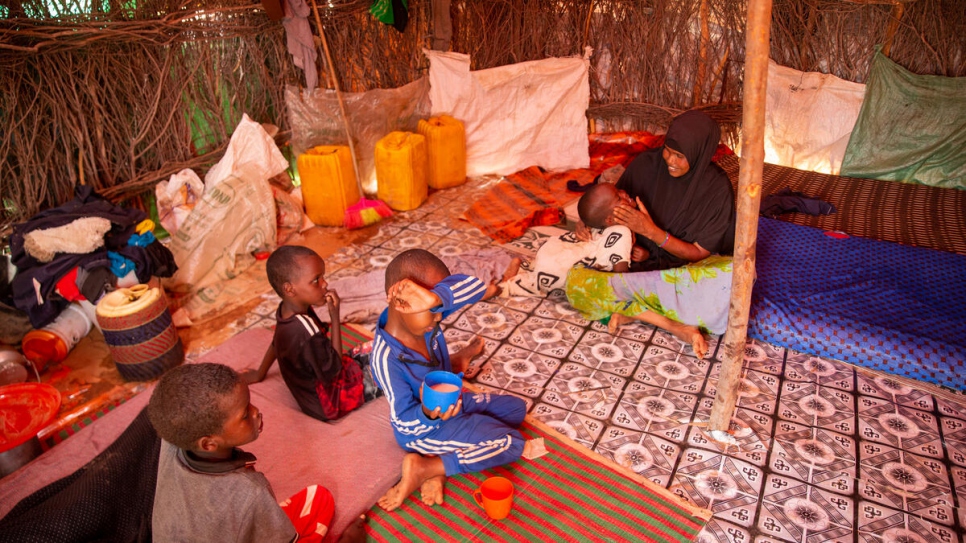Somalis flee drought and conflict to Kenya's Dadaab camps
Some 45,000 Somalis have arrived to Dadaab in 2022 and more are expected to arrive in the coming months, but resources to receive them are stretched.
Dekow Ali, a Somali father of four, sets poles to build a shelter for himself and his family after arriving in Dagahaley camp, Dadaab.
© UNHCR/Charity Nzomo
Back home in Somalia, Dekow Derow Ali, a father of four children, relied on his crops and his livestock to sustain his family. But three years without rain destroyed his livelihood.
“You just plant crops but there is nothing to harvest,” he said. “My cows died at the onset of the drought. I lost some goats as well.”
Dekow sold his remaining goats to pay for transport for him and his family to cross into neighbouring Kenya and reach the refugee camps in Dadaab where they could receive some assistance.
“I came with nothing except my children,” he said.
Famine is looming in Somalia as the country reels from its worst drought in four decades. The failure of four rainy seasons in the last two years, exacerbated by the effects of climate change, has resulted in unprecedented levels of hunger and displaced nearly 1 million people inside the country since last January.
The prolonged drought, combined with ongoing conflict, has sent more than 80,000 Somalis across the border to Dadaab in the past two years, with some 45,000 of them arriving in the last year. As the situation deteriorates, with predictions of yet another failed rainy season, more families are expected to arrive in the coming months.
“More and more people are on the way. When we came, we were many, even yesterday more people arrived,” said Khadija Ahmed Osman, 36, who arrived in October with her eight children after being forced to shut down the small restaurant she owned in Salagle town in Somalia’s middle Jubba region.
“Businesses closed down as people fled due to the drought and insecurity,” she said. “I wanted to protect my young boys from being recruited by armed groups, so I decided to come here.”
In Dadaab, UNHCR, the UN Refugee Agency, is providing newly arrived families with cash assistance, clean drinking water and hygiene facilities, as well as targeted services for the most vulnerable, such as malnourished children.
But resources are overstretched. The ongoing drought has also impacted the more than 230,000 refugees and asylum seekers already living in the series of camps that make up Dadaab, as well as the surrounding host communities.
“We are only using the meagre resources that we have for our regular programmes to respond to this situation,” said Martha Kow Donkor, UNHCR Community-Based Protection Officer. “The needs are very high, and we are appealing to donors to provide more funding.”
Dadaab has been hosting Somali refugees for more than 30 years. Hussein Ibrahim Mohamed was among the first to arrive in 1992. Now, as a community worker, he is helping the new arrivals to settle in.
“These people are in a difficult situation,” he said. “They have travelled very far. So, I took it upon myself to ask around for contributions, either cash or clothes. I have some of the money donated and I plan to buy plastic sheets for them.”
Khadija said she had been welcomed with open arms by refugees already living in Dadaab, including a relative who built her a shelter. “But we have no food, no shelter and no latrines,” she said.
The overcrowding and lack of sufficient sanitation facilities in the camp have contributed to a cholera outbreak, with almost 500 cases identified since the end of October, many of them children.
UNHCR is working with its health partners to set up additional cholera treatment centres to increase access to healthcare, but the funding shortfall is hampering the response.
UNHCR has received only half of what it needs to respond to the drought crisis affecting the entire Horn of Africa region.
“We urgently need plastic sheeting, tents and other materials for the refugees and new arrivals. We also need medicines, medical supplies and more health staff and we need basic core relief items such as kitchen sets, blankets, jerry cans, soap, female hygiene kits and sleeping mats,” said Martha.




